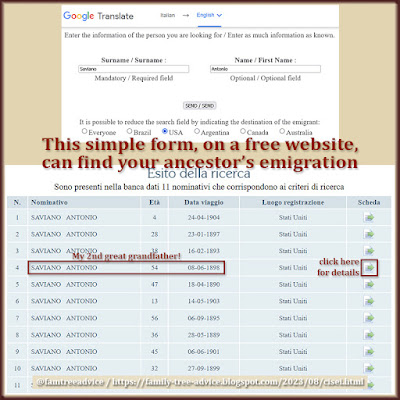Another day, another look at my mom's DNA match list. This time I wanted to find the first still-unknown person in her list worth researching. A video by DNA expert Diahan Southard encouraged me to research a match who shared a long segment of DNA with Mom. That means looking past the total number of shared cM to see the longest "segment" of shared cM.
You can find the longest segment length by clicking the amount of shared cM to see more details. This is true on most if not all DNA websites.
 |
| Researching a DNA match led me to 5 more children of my 3rd great uncle. They were born in another town. |
Increase Your Odds of Success
I began this exercise by looking only at matches who showed a family tree. A quick look at a few trees told me who they were. "Oh, that's my 3rd cousin through Immacolata Leone. Noted."
The match I chose to research has my great grandmother's maiden name in her family tree. Saviano. I'm always interested in finding another Saviano. And they've been hard to find.
This match shares with Mom a longest segment of 27 cM. Diahan Southard didn't specify a longest-segment range worth researching, but her example showed 32 cM. So 27 cM is pretty close.
Do the Research Yourself
First I had to figure out my connection to her ancestor, Giuseppe Saviano. This match supplied an exact birth and death date for him in her family tree, but no locations. I knew the dates would be a big help.
A search on Ancestry told me Giuseppe came to America and lived in Cleveland, Ohio. I know lots of relatives who wound up in Cleveland, including my father. I found Giuseppe in someone else's Ancestry tree. He had the right dates, Cleveland as his place of death, and San Nicola, Salerno, Italy, as his place of birth.
My absolute first thought was, "I wonder if he was really born in San Nicola Manfredi." (That's in Benevento, not Salerno.) Why would I think that? Because that town borders the town where my Saviano ancestors were born. I know there was a decent cross-over between the two towns. And I have all the San Nicola Manfredi vital records at my disposal. I've found many familiar last names in the San Nicola Manfredi vital records.
So, was Giuseppe Saviano actually born in San Nicola Manfredi on 1 Jan 1889? Check the documents—yes! Here he is. And Giuseppe's U.S. World War II draft registration card confirms he was born in San Nicola Manfredi on 1 Jan 1889.
But the true brick-wall busting moment came from the other facts on that birth record. Giuseppe's parents were Giovanni Saviano and Giuseppa Sarracino. I know that couple! They're in my family tree!
In my tree I saw Giovanni was my 3rd great uncle. He's one of only two siblings I've found for my 2nd great grandfather, Antonio Saviano. They come from a little hamlet called Pastene in a town called Sant'Angelo a Cupolo. The town was part of the Papal States, so they didn't keep civil records before 1861. Don't get me started on that. I could cry at the dead ends that causes me.
I'd already found 6 children for Giovanni and Giuseppa. They were all born in Pastene or in greater Sant'Angelo a Cupolo. One of their daughters came to America in 1898 with my 2GG Antonio Saviano and his family. She died in 1901. But I don't know anything else about the other children.
Expand Your Search Area
Thanks to this DNA match and a hunch, I now know Giovanni Saviano and Giuseppa Sarracino moved to neighboring San Nicola Manfredi. Or maybe the borderline moved and they stayed put. Either way, they had 2 more sons in San Nicola Manfredi in 1889 and 1890. I went through the birth records year-by-year looking for more. What I found tells me that Giuseppa died and Giovanni remarried and had 3 more children.
I wish the last 3 were born at the same address as the previous 2, but they weren't. I do know this Giovanni Saviano is the only one around who's having children during these years. And, like his brother (my 2GG), his occupation changes all the time:
- 1875–1880: farmer
- 1882–1885: merchant
- 1889: shopkeeper
- 1890–1896: industrialist
- 1898: farmer again
- 1901: shopkeeper again
The best thing about this discovery is that I've found Saviano cousins with roots in Ohio.
Lessons Learned
What lessons have I learned from this research?
- Don't frustrate yourself with DNA matches who show no family tree. Unless their shared matches have a story to tell, you may get nowhere.
- You may not find your connection to a DNA match with a short "longest segment." I don't know where the cutoff is, but you've got a better chance of success if their longest segment is about 30 cM or more.
- When your DNA match's family tree has sparse details, research their ancestor yourself. You may be more interested in genealogy research than they are. Or they may prefer to limit how much information they put out there.
- Spend time with online maps. Know the names of the towns surrounding your ancestor's town. Take a peek at records for neighboring towns to see if any last names are familiar to you.
I'm thrilled to make some kind of progress on my mother's dead-end branch. While I can't see vital records from their town before 1861, I may find traces of my family in neighboring towns.



